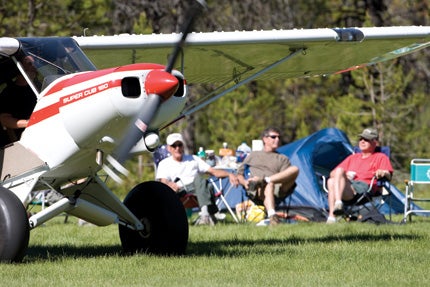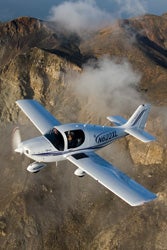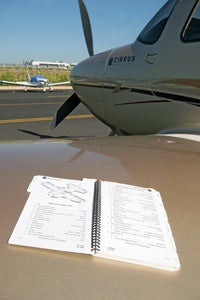 All of us have spent considerable time observing our fellow aviators' takeoffs, landings, radio communications, preflight inspections and general behavior at (and away from) the airport. The group I camp with at Oshkosh is a mix of private and commercial pilots, flight instructors, a few seasoned airline and military pilots and an increasing number of student pilots. Each year, as we lounge in beach chairs in the "North 40" while watching evening arrivals, our typical observations include: "Looks high and fast." "Too low, too slow." "Great landing!" "Amazing recovery!" "Must be a student pilot." "Smooth!" "Wow, we could learn something from her."
All of us have spent considerable time observing our fellow aviators' takeoffs, landings, radio communications, preflight inspections and general behavior at (and away from) the airport. The group I camp with at Oshkosh is a mix of private and commercial pilots, flight instructors, a few seasoned airline and military pilots and an increasing number of student pilots. Each year, as we lounge in beach chairs in the "North 40" while watching evening arrivals, our typical observations include: "Looks high and fast." "Too low, too slow." "Great landing!" "Amazing recovery!" "Must be a student pilot." "Smooth!" "Wow, we could learn something from her."
 |
Is our Oshkosh group that different from any other group of pilots? Probably not. Consciously or subconsciously, we all place judgments on other pilots and ask the same questions: Are they safe? Would I fly with them? Would I handle the situation better than they did?
One evening, alongside runway 9, a few of us (mostly instructors---you'll never get more opinions than from a group of CFIs) debated over what differentiates a truly good pilot from the masses. We didn't agree completely, but we did achieve some consensus on the qualities we admire. To round out that discussion, I queried a number of instructor colleagues, everyday pilots and students on their observations of what characterizes a great pilot.
1. THOROUGH Performing a complete preflight inspection (in and out of the cockpit) and using a checklist are two basic disciplines drilled into us before we set foot in our first airplane. Yet we frequently hear about control locks not being removed and, too often, witness $100 hamburger pilots just jump into their planes and take off---no preflight, no run-up, no nothing. Whether using a laminated card, a panel-placarded list or even well-practiced mnemonics, a consistent process is the best way to defend yourself from dumb, preventable mistakes. Even between short flights, performing a simple walk around before departing will ensure that your prop lock is off and the cowl plugs are removed, and that you're not going to taxi with the asphalt securely attached to your tie down ring.
 Weather briefings and flight planning are the other basic tasks ingrained early on in training. But, for some reason, many pilots believe they can save time by "winging it" or by simply depending on the GPS.
Weather briefings and flight planning are the other basic tasks ingrained early on in training. But, for some reason, many pilots believe they can save time by "winging it" or by simply depending on the GPS.
Neither Mother Nature nor the publishers of the temporary flight restrictions (TFRs) have the slightest tolerance for a lack of planning.
Is it likely that something significantly bad could happen with the airplane or with the weather in the hour or two after taking off? My friend Captain John would answer, "Probably not, unless it does!"
2. CALM, COOL & COLLECTED The first time I took my father for an airplane ride (20-plus years ago, with the ink still wet on my certificate), we were climbing through about 100 feet in a rented Cessna 150 when there was a sudden, loud pop, and a rush of air swirled through the cockpit. I nearly jumped out of my skin, but Dad, a commercially rated pilot and generally calm guy, just smiled and said, "Would you like me to close the door now, or leave it open and enjoy the breeze?" His response certainly made me relax---we kept climbing and eventually closed the door. That kind of calm demeanor is the difference between "reacting" and "responding" to a situation. Responding allows us to remain focused on the task at hand: flying the airplane, making passengers comfortable, and then dealing with other issues. Reacting causes our attention to be diverted and thought processes to become erratic.
3. MODEST Joe, a well-known CFII in Maryland, related a tale of a gentleman who came to his flight school to get "checked out" in a Cessna 172 after having been away from flying for a few years. The lapsed pilot presented himself as a very-high-time instrument pilot with thousands of hours in high-performance singles and light twins. He regaled Joe with stories of harrowing flights through bad weather and the skill with which he could land his Comanche in 800 feet, over obstacles, on a windy day. As the gentleman lumbered toward the Skyhawk, he told Joe to do the preflight since he already knew how to do one. He then suggested that Joe handle the radios so they could expedite the checkout process. They did take a short flight, but predictably, it didn't go well. He never returned for another flight.
Skipping a full Freudian analysis, there are many examples of this attitude in a pilot eventually leading to something getting broken. The FAA refers to terms like compensation, denial, rationalization and aggression to describe behaviors that must be managed in the process of becoming a pilot. Nearly all of the examples I've gathered about good pilots contain a common thread of that person not talking "all that much" about his or her specific accomplishments and skills. These pilots do, however, acknowledge their own mistakes (neither dwelling on nor making excuses), compliment others' abilities and seldom put down fellow pilots (whether or not they deserve it). As our grandmothers' always preached, "If you have nothing good to say, say nothing at all."
4. COMPETENT One day last year, an exceptionally enthusiastic pilot who had recently passed his private checkride, approached me with a big grin on his face. Apparently, he had just been out practicing slow flight and stalls (albeit, somewhere up near the flight levels)---these were all maneuvers that had once made him more than a little uncomfortable. The following week, the same pilot spent an afternoon flying into a number of controlled (Class D) airports in the area---an activity that once made him significantly more nervous than doing power-on stalls. He knew how to do these things, but realized that only practice would get him over the hump to real competency. He was right. Any learned skill is diminished by lack of use. All those hours spent in the training phase were specifically designed to build skills that, ironically, are most often used during very short phases of flight. Turns about a point, S-turns, slow flight and stalls are the very maneuvers that, once mastered, allow us to operate safely in that little space around the airport where we fly slowly and close to the ground. Remaining current has little to do with being competent or building experience. A wily FAA inspector in New England was often known to say, "Some pilots have logged 500 hours, and some have logged one hour 500 times." There's a big difference.
 Through proper training and practice, great pilots learn how to smoothly and subtly maintain control of an aircraft. They demonstrate self- and situational awareness, and are always open to learning new things. |
5. ACTIVE IN THE PURSUIT OF LEARNING Those who actively participate in the aviation community have little choice, simply by exposure, but to learn things that will improve their flying. A whole lot of research has concluded that education reduces accidents---just ask the FAA, NTSB and insurance companies. Hundreds of seminars on dozens of topics are held yearly by all the big alphabet groups and local FBOs; these are not only potentially fun social outings but also learning opportunities. Did you know that a Cessna 172 has a tested structural limit of 2 G's with flaps fully extended? I know a respected airline captain and accomplished tailwheel instructor who constantly asks other pilots about their experiences and opinions on various techniques. He doesn't do this because he lacks experience or knowledge, but because he's open to learning new things and doesn't assume he already knows everything. A few of our good pilot examples use their biannually required flight review as a learning experience. Some have added a float or glider rating. Many suggest using a type of airplane you've never flown or getting a high-performance or tailwheel endorsement.
 One of the first things that all pilots learn is the importance of performing a thorough preflight inspection with a checklist on every flight. |
6. SMOOTH ON THE CONTROLS One of the greatest compliments a pilot can receive is how smoothly he or she flies an airplane. Often, this comes in the form of a "nice landing" comment from a new passenger who believes that was the true test of a pilot's flying skills. To get a "smooth" comment from a fellow pilot, much less a jaded CFI, requires a much broader demonstration, not to mention consistency. Smooth pilots understand how to use those footrests on the floor to counteract adverse yaw---not only during turns but also while correcting for bumps and turbulence. They intuitively keep the plane aligned with the runway while correcting for a crosswind. They make subtle control (aileron, rudder and power) inputs when needed, so they aren't forced to make large, jerky corrections. Landings are (generally) soft and made precisely where they were intended. Many years ago, an instrument instructor I know claimed that while transporting a well-known rock band, he did a complete roll in a cabin-class twin in an attempt to calm the rowdy group. Unbeknownst to him, the lead singer was in the windowless lavatory. The singer eventually emerged, wondering why everyone was suddenly so quiet. Now that's smooth.
7. SELF-AWARE Every pilot must acknowledge his or her own limitations with regard to weather, personal health and experience or skill level. Establishing personal minimums may sound clichéd, but how many times have you cringed at seeing someone (maybe yourself) take off in marginal weather or in a questionably loaded aircraft? Granted, you must continually gain experience to advance your skill level, but it should be done incrementally and at your own pace. Should a newly minted private pilot launch on a windy night to a short strip in the mountains? No. But by incrementally logging night, wind and short-field time, that pilot will gradually be able to raise his or her minimums.
8. SITUATIONALLY AWARE My friend JW used to throw rocks at helicopters, or so he claimed. The helicopter school at his field had a habit of conducting taxi and hover practice very near JW's (rather plush) hangar, routinely washing his beloved Cardinal with dirt and gravel. After the helo pilots found a bucket of dirt in their own hangar, a friendly discussion ensued, and they confessed that they simply weren't aware of the disturbance they had been creating. On the ground, a good pilot is simultaneously aware of open hangars, people, fuel pumps, taxiways, wind socks and aircraft in the pattern, and has a plan to navigate the situation as a whole. In the air, pilots should simultaneously be aware of terrain, landmarks, airspace, wind, weather, charts, radios, engine instruments and sounds, passengers, other aircraft and probably a dozen more things. Digesting all this awareness requires an enormous amount of focus. A new pilot recently took a friend up for his first ride in a small plane. After a short briefing by the pilot, the friend asked how she managed to do all these things while talking with passengers. She quickly replied, "I ask the passengers to be quiet. Oh, and could you hold the yoke for me while I do my run-up?" Wide-eyed and very quiet, the friend performed his task to perfection.
9. INVOLVED WITH THE AIRCRAFT Over the past few years, it seems to have become more common for pilots to participate in the annual inspections of their planes. There's no better way to learn where those maintenance dollars or rental fees go than to spend a few hours removing inspection panels or attempting to replace an oil filter through an opening half the size of your fist. More importantly, it provides a perspective that many pilots seldom experience: the other side of the cowling. Perhaps having a complete understanding of how the valve train is assembled isn't a critical factor in being a good pilot. Understanding in detail how landing gear goes up and down, however, probably is. Three experienced mechanics shared a list of questions that generally competent pilots typically ask them: What's the correct air pressure for each tire and what's the acceptable amount and pattern of wear? Where's the battery and what's its voltage? What type and grade of oil should I use and why? How do I start up when it's hot/cold? For some, these seem like simple questions, but for many, a day in the maintenance shop would make them better pilots.
10. ENDORSED BY OTHER PILOTS Every person, without exception, whose thoughts I've incorporated in this "top 10" list began by naming a specific pilot who fit his or her perception of a great pilot. With each name came a story to justify the "great" designation. On the whole, aviators are a proud and confident group. We're not a shy bunch, and if asked for an opinion, we'll offer one. And we've all been through the same training. To be nominated as a truly good pilot by one's flying peers certainly carries credibility---especially if the nominee doesn't believe it too much.
Cal Thomas is a 3,500-hour instrument-rated pilot and CFI who has given 1,400 hours of primary and tailwheel instruction. He holds single- and multi-engine seaplane ratings and enjoys flying his L-4 Cub and Cessna 180 throughout the Northeast.
| CAUTION SIGNS |
| Everyone makes mistakes and suffers from an occasional error in judgment, but if these mistakes and errors are made consistently or intentionally, they should serve as a sign of caution.
⢠Poor airport etiquette: Straight-in approaches, ignoring noise abatement and prop blasting are just a few signs of not knowing or not caring. [For more, read "Mrs. Manners Addresses Your Most Pressing Flying Etiquette Questions" from P&P March 2008.] |

Subscribe to Our Newsletter
Get the latest Plane & Pilot Magazine stories delivered directly to your inbox






